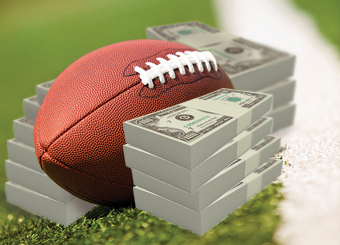 Tonight at 8:00 p.m., the National Football League will hold
its annual draft. This is the moment hopeful college football players find out
if they will continue their sports career on the professional level and where
they will be playing next. It is the most anticipated draft night in all of
sports, with all sorts of speculation and mock drafts surrounding the event.
But as those young men cash in on their fortune (they literally will become
millionaires at the call of their name), I wonder how many of them truly
understand that the NFL is actually a marketing venture.
Tonight at 8:00 p.m., the National Football League will hold
its annual draft. This is the moment hopeful college football players find out
if they will continue their sports career on the professional level and where
they will be playing next. It is the most anticipated draft night in all of
sports, with all sorts of speculation and mock drafts surrounding the event.
But as those young men cash in on their fortune (they literally will become
millionaires at the call of their name), I wonder how many of them truly
understand that the NFL is actually a marketing venture.
In 1920, 14 football teams formed a league known as the
American Professional Football Association. They later changed the name to the
National Football League. The league was formed to help with scheduling and to
formalize a way for each franchise to secure their own players without another
team pilfering them, to establish rules, and to raise the level of play. As
they did, teams began to see the value of selling tickets for their games. That
led to other opportunities, such as broadcast deals (first radio and then TV)
and merchandise sales. The NFL quickly became the negotiator of deals in which
all the league franchises profited. Today, the NFL shares revenue generated
from marketing the league and the 32 franchises it represents. The league
generates revenue by offering a marketing venue for advertisers on television,
selling its own subscription cable packages, and sponsorships for all kinds of
merchandise. Today, it has been reported that 2/3rds of franchise revenues are
produced through the league’s marketing revenue, not through the local
franchise’s ticket sales, stadium sponsorships, concession sales, parking fees,
etc.1 The NFL is a giant marketing firm.
In fact, until 2015, the NFL was registered as a nonprofit
organization. How so? The NFL is merely the marketing arm of 32 franchise
owners. It generates marketing revenues and divvies these funds up 32 ways.
(The reason they dropped their nonprofit status was that so many people
complained that they restructured as a trade association.)
Back to the young football players being drafted tonight:
they are entering the NFL as an employee of one of the franchises and they will
be used to help market the larger NFL, especially if they are good at what they
do. People will want to wear their jersey, pay to watch them play, draft them
in a fantasy league or play them in a video game. All of this is part of the
marketing strategy of the NFL. All of this creates revenue for the franchises.
If you thought the NFL was all about football, think again. Football is just
the vehicle to make the marketing dollars flow. So when you see those young men
walk across the stage and don the hat of their new team, listen carefully, and
you will hear the cash register ringing in the background.
__________________
1. Kansas City Chiefs’
tax returns provide rare look inside the business of pro football, by Mike Hendricks and Steve Vockrodt, Kansas City Star,
February 6, 2019